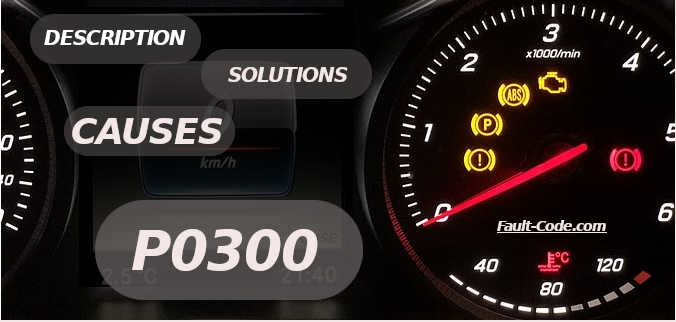Diagnosing Code P0300: Causes, Symptoms and Solutions in the Ignition System
Introduction
The P0300 error code means that the engine’s onboard computer (ECU) has detected a problem with one or more cylinders. Unlike codes that point to specific cylinders (e.g. P0301 for cylinder number one), the P0300 code signals general engine misfires. In this article, we’ll look at the causes, symptoms, and solutions for the P0300 error.
Technical description and decoding of error P0300
What does code P0300 mean?
The P0300 code indicates that there are random or multiple misfires in the engine cylinders. This can lead to unstable engine operation, which can be caused by a variety of problems.
Why does code P0300 occur?
Code P0300 may be caused by:
- Leaks in the intake system
- Ignition coil failure
- Problems with the fuel or injection system
- Spark plug damage
- Errors in the engine electronics system
Symptoms of error P0300
Symptoms associated with code P0300 may include:
- Check Engine Light (MIL): The Check Engine light on the dashboard illuminates.
- Engine Running Rough: The engine may run rough, vibrate, or “jerk.”
- Acceleration Problems: Loss of power and acceleration problems.
- Increased fuel consumption: Excessive fuel consumption may occur.
Causes of error P0300
Code P0300 may mean that one or more of the following problems have occurred:
- Damaged spark plugs: Leaking or worn spark plugs can lead to ignition problems.
- Intake system leaks: Leaks can introduce extra air, affecting the air-fuel mixture.
- Ignition coil problems: The coil may be damaged or have a loose connection.
- Injector problems: A malfunctioning injector can lead to incorrect fuel metering.
How to Clear or Reset Error Code P0300
- Reading fault codes: Use an OBD-II scanner to read all fault codes stored in the ECU memory.
- Ignition System Inspection: Check the condition of the spark plugs and ignition coil.
- Injector Test: Check that the injectors are operating properly.
- Code Reset: After making repairs, clear the fault code and test drive the vehicle to make sure the problem is solved.
Diagnostics and troubleshooting
- Read Codes: Identify all fault codes stored in the ECU.
- Spark plug inspection: Check their condition and setting.
- Cylinder Pressure Test: Use a pressure gauge to measure the cylinder pressure.
- Leak analysis: Check for leaks in the intake system and injector connections.
Cost of repairing error P0300
The cost of repairing a P0300 error can vary depending on the source of the problem. Here are the approximate costs:
- Spark plug replacement: USD 100–300
- Ignition coil replacement: USD 300–600
- Ignition system diagnostics: USD 100–400
How to avoid problems with code P0300 in the future?
To minimize the risk of error P0300, it is worth following a few rules:
- Regular maintenance: Check the condition of the spark plugs and ignition coil regularly.
- Oil change: Maintain proper engine oil quality to prevent damage.
- Respond quickly to problems: If you notice any symptoms of engine problems, have your vehicle diagnosed immediately.
FAQ (Frequently Asked Questions)
1. What are the symptoms of a P0300 code?
Symptoms include an illuminated check engine light, rough engine operation, and difficulty accelerating.
2. What are the most common causes of the P0300 error?
Common causes include faulty spark plugs, intake system leaks, and ignition coil problems.
3. Can I fix the P0300 error myself?
Yes, you can check the spark plugs and coils yourself, but for more serious problems, it is worth consulting a professional.
4. What tools are needed to diagnose the P0300 error?
An OBD-II scanner, a multimeter to measure voltage, and basic mechanical tools will be useful to diagnose the P0300 error.
Final Summary
The P0300 code indicates problems with the ignition in the engine cylinders. Understanding this error and regular maintenance of the ignition system are key to keeping your vehicle in good condition. If you are having difficulty diagnosing or repairing your vehicle, it is a good idea to consult a professional mechanic to avoid further problems with your vehicle. Taking care of your ignition system is key to ensuring safe and efficient driving.
